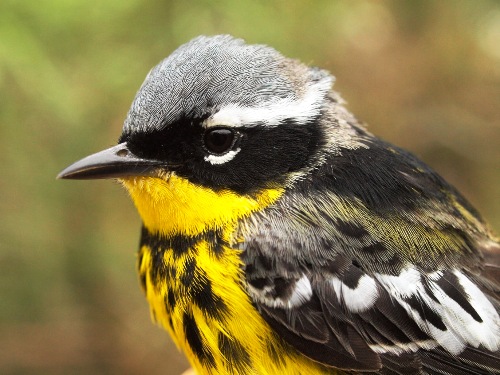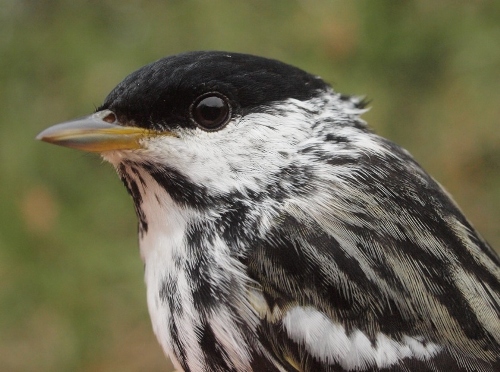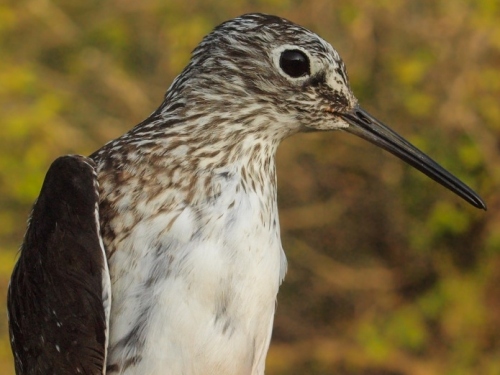|
|
THIS WEEK |
THIS SPRING |
2014 TOTAL |
SITE TOTAL |
|
# birds (and species) banded |
305 (43) |
755 (56) |
755 (56) |
47065 (114) |
# birds (and species) repeat |
51 (18) |
123 (22) |
123 (22) |
9257 (70) |
|
# birds (and species) return |
33 (10) |
85 (18) |
85 (18) |
1519 (38) |
|
# species observed |
99 |
125 |
126 |
209 |
|
# net hours |
538.3 |
1778.4 |
1778.4 |
80961.7 |
|
# birds banded / 100 net hours |
56.7 |
42.5 |
42.5 |
58.1 |
|
|
Note: table does not include nocturnal banding (owls) |
Banders-in-charge: Simon Duval, Gay Gruner
Assistants: Cindy Bouchard, Luke Currin, David Davey, Geneviève Dubois, Barbara Frei, Alison Hackney, Jessica Head, James Junda, Lisa Keelty, Helen Kohler, Barbara MacDuff, Francine Marcoux, Betsy McFarlane, Marilou Skelling, Patricia Stotland, Rodger Titman
Notes: After a couple of rather slow weeks of migration, the dam burst this week, producing one of the busiest periods McGill Bird Observatory has had in ten years of spring migration monitoring! The 305 birds banded this week is a new record for the season, narrowly eclipsing the previous high of 299 in week 8 of 2009. The 43 species banded this week was a near record, while the 99 species observed was a new high count for week 7, and a most welcome contrast to last week’s below-normal diversity … a sign of just how quickly things can change, especially in spring. As a result, the season total of 125 species to date is now also well above average.

A striking male Magnolia Warbler; next to Yellow-rumped Warbler, it was the most abundant of the 15 warbler species banded at MBO this week.
(Photo by Simon Duval)
|
Of the 43 species banded this week, a whopping 27 of them were new for this spring. Over half of these (14) were warblers: Tennessee, Orange-crowned, Nashville, Yellow, Chestnut-sided, Magnolia, Black-throated Blue, Yellow-rumped, Blackpoll, Black-and-white, Wilson’s, Common Yellowthroat, American Redstart, and Ovenbird. The first two vireos of the year (Warbling and Red-eyed) were also on that list, as well as Solitary Sandpiper (only our third ever banded at MBO), Least Flycatcher, Eastern Kingbird, House Wren, Swainson’s Thrush, Gray Catbird, Lincoln’s Sparrow, White-crowned Sparrow, Northern Cardinal, Baltimore Oriole, and Purple Finch.
The list of species observed for the first time this spring over the course of week 7 is even longer – a jump of 40 species! Among those were all the warblers listed above, plus an additional 7: Northern Parula, Cape May, Black-throated Green, Blackburnian, Bay-breasted, Mourning, and Canada. While spring migration is more concentrated than in fall, we have never before had the arrival of warblers occur in such a narrow band of time. The other new arrivals were five waterbirds (American Bittern, Green Heron, Virginia Rail, Spotted Sandpiper, Greater Yellowlegs), three flycatchers (Alder, Least, Great Crested), two vireos (Philadelphia, Red-eyed), four thrushes (Eastern Bluebird, Veery, Swainson’s Thrush, Wood Thrush), and four other assorted songbirds (Rose-breasted Grosbeak, Indigo Bunting, Bobolink, and Baltimore Oriole). Except for May 12, there were at least three new species daily, making it exciting to turn up every morning – but nothing matched May 10, when 16 new species for the season were observed.
This week’s
top 10 [last week's top 10 in brackets]
#
individuals banded |
mean # individuals observed daily |
1. Yellow-rumped Warbler (45) [-] |
1. Canada Goose (97) [1] |
2. American Goldfinch (26) [10] |
2. Ring-billed Gull (84) [4] |
3. Ruby-crowned Kinglet (24) [3] |
3. Red-winged Blackbird (51) [2] |
4. Magnolia Warbler (19) [-] |
4. Yellow-rumped Warbler (20) [-] |
5. Red-winged Blackbird (17) [1] |
5. Cedar Waxwing (18) [3] |
6. Northern Waterthrush (16) [7] |
6. Song Sparrow (16) [5] |
6. Common Yellowthroat (16) [-] |
7. American Goldfinch (14) [-] |
| 8. Yellow Warbler (15) [-] |
8. Yellow Warbler (11) [-] |
| 9. Least Flycatcher (14) [-] |
9. Black-capped Chickadee (11) [7] |
10. Baltimore Oriole (11) [-]
|
10. Cliff Swallow (11) [-]
|
|
For six of the past eight years, Red-winged Blackbird has been the top species banded in week 7, but this year it dropped to fifth place, with the total of 17 also well below average. Instead, Yellow-rumped Warbler took first place, as in 2010 and 2012; the count of 45 this week was slightly above the previous high of 41 two years ago. Reflecting the mass arrival of warblers this week, another four species were among the top ten species banded – the third year in a row that there have been at least five warblers on the list for week 7, whereas in all previous years the high had been four. Is this evidence of the spring migration of Neotropical species advancing over time? Similarly, Baltimore Oriole numbers have never before been so strong this early in spring – and in fact, the 11 individuals banded this week were more than the totals for any of the past three spring seasons.
From 2005 through 2010, American Goldfinch was a fixture in week 7, always among the top six species banded – yet in the three years that followed, it never even cracked the top ten. This year that trend reversed itself with a vengeance, the 26 individuals banded being the highest ever count at this time of year. Usually Ruby-crowned Kinglets are well past their peak by week 7, with a mean total of 7 individuals banded; the 24 this week was a new record high for the period, slightly more than in 2008 (yet another parallel with the migration patterns from that spring). Last but not Least (pun intended), the 14 Least Flycatchers banded this week was a remarkable count for two reasons. Not only did we eclipse all previous spring season totals in a single week, but they were also early arrivals, regularly peaking in week 8 otherwise.
With
regard to observations, Canada Goose clung to top spot for another week, matching its position for week 7 for four of the previous years. The only exception was last year, when this week’s runner-up, Ring-billed Gull, jumped out in front. Red-winged Blackbird is the only species that has been in the top three for week 7 in all ten years of our Spring Migration Monitoring Program. A fair distance behind in fourth place was the strong initial push of Yellow-rumped Warblers; as usual, Yellow was the only other warbler common enough to register in the top ten of species observed. Cedar Waxwing numbers continue to drop from week to week, but remained enough to round out the top five – and this marks only the third time in ten years that they have been common enough in week 7 to make the list. The increase in American Goldfinches that we saw on the banding list was reflected to some extent in observations as well, while Song Sparrows and Black-capped Chickadees more or less maintained their numbers from last week.
|

Blackpoll Warbler is traditionally among the latest spring migrants to arrive at MBO,
yet it was among the 22 warbler species observed this week.
(Photo by Simon Duval)

Six Baltimore Orioles at once! An impressive increase over spring
2013, when only 7 were banded all season long.
(Photo by Simon Duval)
|




